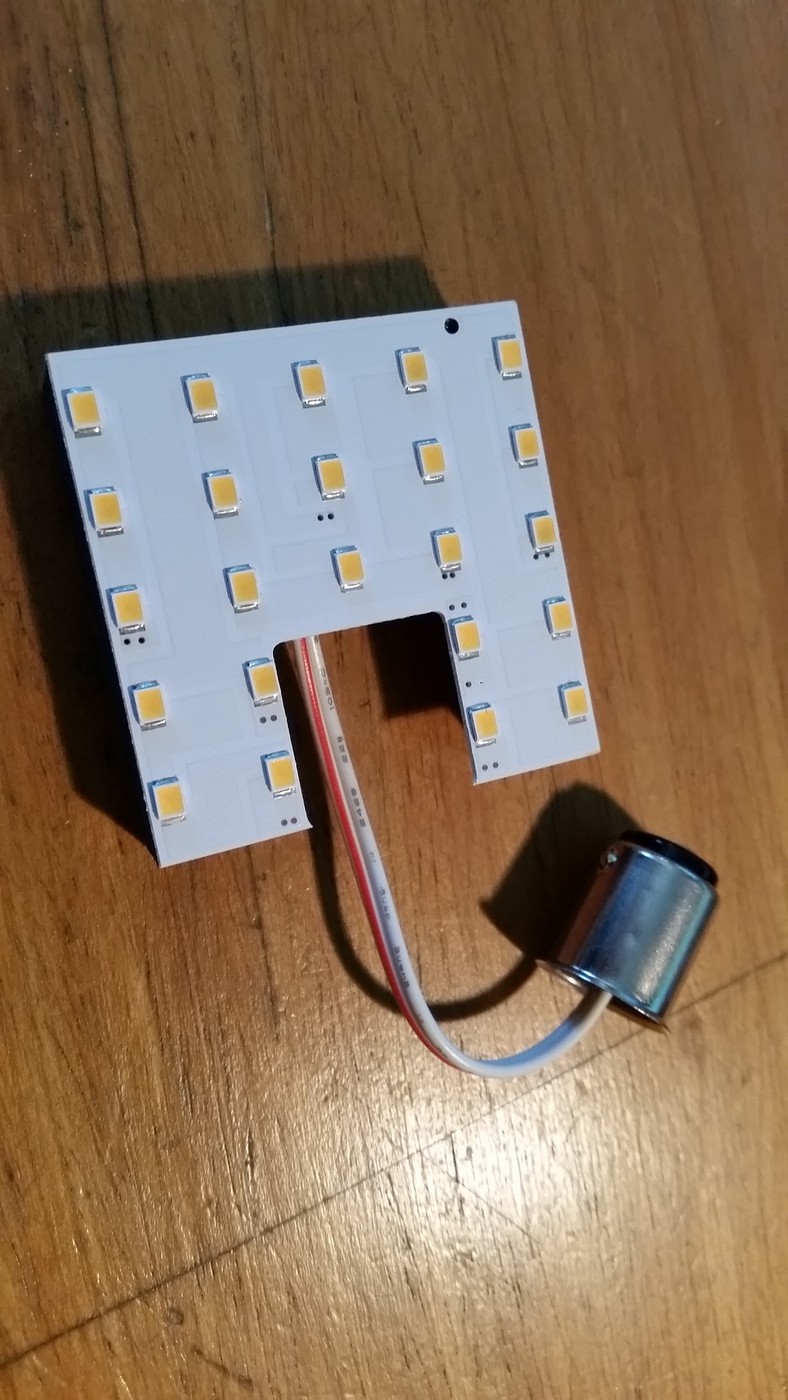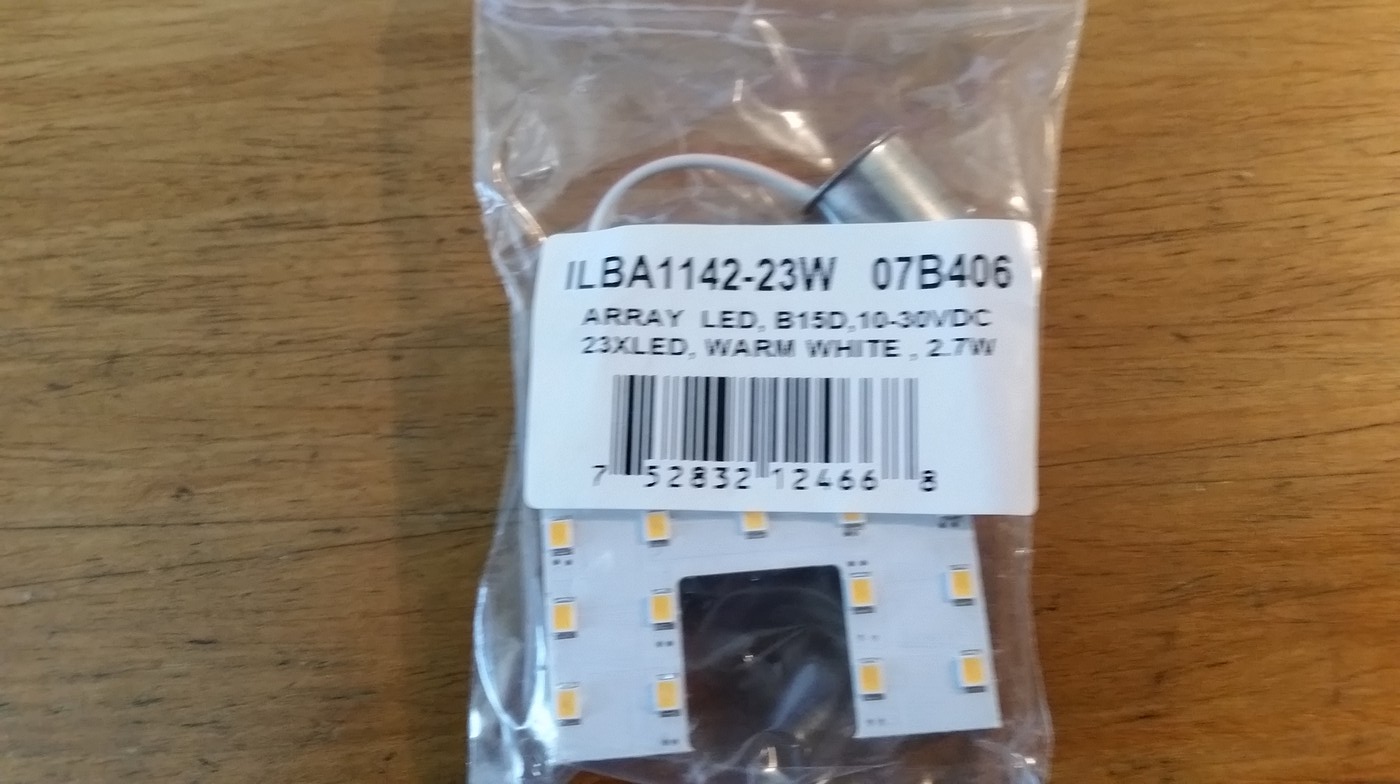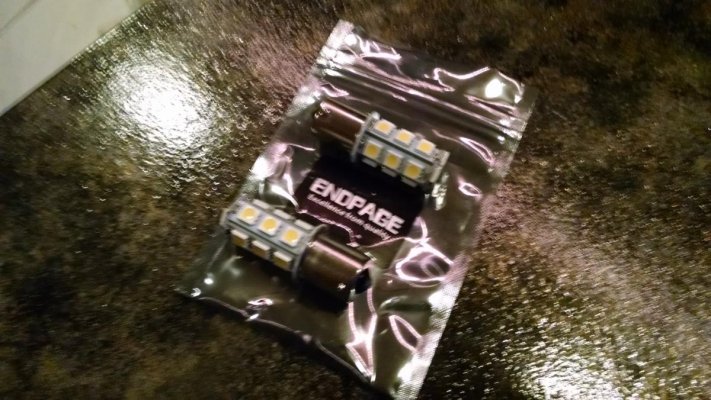You are using an out of date browser. It may not display this or other websites correctly.
You should upgrade or use an alternative browser.
You should upgrade or use an alternative browser.
Switching bulbs to LED
- Thread starter SkyRockin
- Start date
The friendliest place on the web for anyone who enjoys boating.
If you have answers, please help by responding to the unanswered posts.
If you have answers, please help by responding to the unanswered posts.
ancora
Guru
- Joined
- Dec 16, 2007
- Messages
- 4,022
Tried doin' that but the LEDs were woefully lackin' in Lumens.
Conrad
Guru
- Joined
- Oct 19, 2007
- Messages
- 1,972
- Location
- Canada
- Vessel Name
- Blue Sky
- Vessel Make
- Nordic Tugs 42 Hull #001
Tried doin' that but the LEDs were woefully lackin' in Lumens.
We had the same experience sort of; noticeably dimmer. However, we also found that a similarly spec'd LED from a different source was much brighter, so I guess you really have to pay attention to what you're purchasing.
ranger58sb
Guru
We've changed all interior, all engine room, some exterior, and all courtesy lighting to LED, and we also changed the whole anchor/mastlight fixture to LED. In ALL cases, the LEDs put out more light, in some cases LOTS more light (the anchor light, for instance).
At the same time, we've reduced DC power consumption for lighting by about 90%.
It pays to shop; compare lumens or candela, compare color temperature (~2700°K is approximately the warm lighting incandescent bulbs provide), compare voltage capability (you want LEDs that can deal with something like 10-30VDC, NOT just straight 12V LEDs), compare heat sink capabilities, and when necessary compare whether dimmable or not.
FWIW, most of ours have been from marinebeam.com, not cheap, and some from superbrightleds.com, ditto not cheap. Some of the earlier LEDs I used from a different source had some heat issues, so we replaced.
Another FWIW, I think the specific product name for our G4 bi-pins -- most of our serious interior lighting -- is marinebeam's "Force 12" or something like that. 12 LEDs per disc, warm white (2700°K), dimmable at least on our dimmers.
-Chris
At the same time, we've reduced DC power consumption for lighting by about 90%.
It pays to shop; compare lumens or candela, compare color temperature (~2700°K is approximately the warm lighting incandescent bulbs provide), compare voltage capability (you want LEDs that can deal with something like 10-30VDC, NOT just straight 12V LEDs), compare heat sink capabilities, and when necessary compare whether dimmable or not.
FWIW, most of ours have been from marinebeam.com, not cheap, and some from superbrightleds.com, ditto not cheap. Some of the earlier LEDs I used from a different source had some heat issues, so we replaced.
Another FWIW, I think the specific product name for our G4 bi-pins -- most of our serious interior lighting -- is marinebeam's "Force 12" or something like that. 12 LEDs per disc, warm white (2700°K), dimmable at least on our dimmers.
-Chris
I also replaced saloon, cabin & ER halogens w/ LED. I've had several (from different suppliers) several have quit and need replacement. I've started to pay close attention to V range as mentioned.
A draw was reduced by approx 90%
A draw was reduced by approx 90%
O C Diver
Guru
- Joined
- Dec 16, 2010
- Messages
- 12,867
- Location
- USA
- Vessel Name
- Slow Hand
- Vessel Make
- Cherubini Independence 45
I went with hero-led.com. You're buying directly from china. They offer the 10 to 30 volt DC G4 replacements which have been great. As mentioned, you need to go with the brightest ones in warm white for living areas. Prefer the day light or cool white.for the engine room and anchor light. Out of about 100 units I've had 2 failures. I consider this acceptable for the savings. Would also agree with about a 85 to 90% power savings.
One note of caution : you need to down size fuses. These are electronic devices that in rare instances can fail and start a fire if there is enough amperage behind it. I doubled the amount of fixtures in the engine room and converted to LED. There use to be a 40 amp breaker for that circuit. It's now a 5 amp breaker.
Ted
One note of caution : you need to down size fuses. These are electronic devices that in rare instances can fail and start a fire if there is enough amperage behind it. I doubled the amount of fixtures in the engine room and converted to LED. There use to be a 40 amp breaker for that circuit. It's now a 5 amp breaker.
Ted
.........compare voltage capability (you want LEDs that can deal with something like 10-30VDC, NOT just straight 12V LEDs),..............
This is critical and not doing this is the reason for so many reports of failures. A 12 volt LED requires 12 volts. Actual DC voltage on a boat can vary quite a bit and with battery charging, it can be 14 volts or more. This will shorten the life of LEDs considerably.
The way the 10-30 volt LEDs work is, inside the case is a "driver" that monitors the current through the LEDs and controls it by turning the power on and off at high rate that's not visible to the human eye.
LEDs (usually there are several LEDs in a "lamp") typically use 10% of the power of incandescent lamps of the same intensity. That's a good reason to use them on a boat.
LEDs (usually there are several LEDs in a "lamp") typically use 10% of the power of incandescent lamps of the same intensity. That's a good reason to use them on a boat.[/QUOTE]
Mine are rated 14 1/2 watts to equal 100 watt incandescent, so pretty
close to 10%
Ted
Mine are rated 14 1/2 watts to equal 100 watt incandescent, so pretty
close to 10%
Ted
Old deckhand
Guru
Another vote for Marinebeam.
C lectric
Guru
We've changed all interior, all engine room, some exterior, and all courtesy lighting to LED, and we also changed the whole anchor/mastlight fixture to LED. In ALL cases, the LEDs put out more light, in some cases LOTS more light (the anchor light, for instance).
At the same time, we've reduced DC power consumption for lighting by about 90%.
It pays to shop; compare lumens or candela, compare color temperature (~2700°K is approximately the warm lighting incandescent bulbs provide), compare voltage capability (you want LEDs that can deal with something like 10-30VDC, NOT just straight 12V LEDs), compare heat sink capabilities, and when necessary compare whether dimmable or not.
FWIW, most of ours have been from marinebeam.com, not cheap, and some from superbrightleds.com, ditto not cheap. Some of the earlier LEDs I used from a different source had some heat issues, so we replaced.
Another FWIW, I think the specific product name for our G4 bi-pins -- most of our serious interior lighting -- is marinebeam's "Force 12" or something like that. 12 LEDs per disc, warm white (2700°K), dimmable at least on our dimmers.
-Chris
Chris is dead on.
Too many just go for any old LED. Not likely going to give acceptable results. There is more to buying a suitable LED than just that it is LED.
Done properly you can substantially drop power usage, keep the brilliance you have now or improve it where needed, keep the warm white most of us want and so on.
Even the voltage range is important. 10-30VDC will keep the same light output under varying voltage supplies which is important.
I used a source other than Marinebeam or Superbright but the same needs applied and I got a nice light for both the boat and my trailer.
The old boat bulbs each drew ~ 1.8A at nominal 12V. The LED draw about 200mA and throw more light. I can now run all 6 salon lights with less draw than one of the old bulbs, not that we do that. I explain this only to highlight the power use reduction available.
But do not look at that power reduction only or you may still be disappointed.
SkyRockin
Member
- Joined
- Jan 28, 2017
- Messages
- 19
- Location
- USA
- Vessel Name
- Fool Moon
- Vessel Make
- 36 Mainship Nantucket
good advise. I'll proceed to replace my automotive style 1141 incandescent bulbs with LED's of similar lumens and color temperature and report results.
I ended up replacing qty 14 of my cabin overhead incandescent bulbs with Amazon cheapies Endpage LED's ($2 per bulb). One of the bulbs was defective out of the package. Current draw reduction is similar to other's posted results. Brightness very similar to the incandescent- warm white. Tested with voltages from about 10.5- 13 volts. So far very happy with the switch.
Attachments
High Wire
Guru
LEDs use about 10 percent of the old incandescent bulbs power. Yes the cheapest are not as bright. Where my wife complains I leave the old. We have just one fixture left over the range to find something bright enough but not offensive.
psneeld
Guru
YepJust a small comment, your fuses/breakers are intended to protect the wires, not the device...
NightCrawler
Senior Member
- Joined
- Feb 17, 2016
- Messages
- 211
- Location
- USA
- Vessel Name
- Previous owner GB 42 Classic
- Vessel Make
- Currently running a 23' CC
We've now completed all interior lighting switched to LED. Shopping running and anchor lites now. One thing we did over the sink/galley was to use a whiter light, still in a low power LED bulb. The rest of the overheads are warmer light and that seems to work fine giving the head chef the light she needs.
Lou_tribal
Guru
Just a small comment, your fuses/breakers are intended to protect the wires, not the device...
and by extension your boat
O C Diver
Guru
- Joined
- Dec 16, 2010
- Messages
- 12,867
- Location
- USA
- Vessel Name
- Slow Hand
- Vessel Make
- Cherubini Independence 45
Just a small comment, your fuses/breakers are intended to protect the wires, not the device...
Then why do all your electronic devices have fuses. Why do bilge pumps, circulating pumps, bow thrusters, winches, specify a fuse or breaker size. Circuits such as power outlets have have fuses / breakers to protect the wires because the load is unknown.
Ted
Xsbank
Guru
- Joined
- Sep 7, 2013
- Messages
- 3,791
- Location
- Canada
- Vessel Name
- Gwaii Haanas
- Vessel Make
- Custom Aluminum 52
Well OC, you have a panel with gangs of breakers or fuses, notice they are all different specifications? Notice how your windlass has a giant breaker and the radio has a small one? Take a look at the ampacity of the wires that are used to power these devices...check this out - Circuit Wizard - Blue Sea Systems
Then why do all your electronic devices have fuses. Why do bilge pumps, circulating pumps, bow thrusters, winches, specify a fuse or breaker size. Circuits such as power outlets have have fuses / breakers to protect the wires because the load is unknown.
Ted
Electronic devices and bilge pumps have individual fuses because they might be wired to circuits that have a different level of overcurrent protection. We might have a 20 amp circuit with two chart plotters, a GPS antenna and a depth sounder module attached. Each device would need individual protection. Or, we could run individual circuits to each and provide protection at the source. Some devices need protection that can't be provided by typical circuit breakers. A GPS antenna fused at one amp, for example.
A bilge pump usually has a fuse because it is usually wired in a way that it bypasses any electrical panel and is powered all the time.
O C Diver
Guru
- Joined
- Dec 16, 2010
- Messages
- 12,867
- Location
- USA
- Vessel Name
- Slow Hand
- Vessel Make
- Cherubini Independence 45
Well OC, you have a panel with gangs of breakers or fuses, notice they are all different specifications? Notice how your windlass has a giant breaker and the radio has a small one? Take a look at the ampacity of the wires that are used to power these devices...check this out - Circuit Wizard - Blue Sea Systems
The point is that often the fuse is specified to protect those devices from catastrophic failure not the wiring that is feeding them.
Electronic devices and bilge pumps have individual fuses because they might be wired to circuits that have a different level of overcurrent protection. We might have a 20 amp circuit with two chart plotters, a GPS antenna and a depth sounder module attached. Each device would need individual protection. Or, we could run individual circuits to each and provide protection at the source. Some devices need protection that can't be provided by typical circuit breakers. A GPS antenna fused at one amp, for example.
A bilge pump usually has a fuse because it is usually wired in a way that it bypasses any electrical panel and is powered all the time.
Yes, I'm fully aware of that. The point that I was originally making was that incandescent lights don't need to be fused to prevent a risk of fire, the circuit does. LED emitters should be fused to protect against the extremely small risk of a fire when they fail. Since the emitter doesn't have a fuse, prudence dictates you limit the circuit (with a fuse or breaker) to the minimum amount of amperage required.
Ted
...... The point that I was originally making was that incandescent lights don't need to be fused to prevent a risk of fire, the circuit does. LED emitters should be fused to protect against the extremely small risk of a fire when they fail. Since the emitter doesn't have a fuse, prudence dictates you limit the circuit (with a fuse or breaker) to the minimum amount of amperage required.
Ted
Your point wasn't clear to me.
You are correct and in fact, I did that when I changed my interior lights to LEDs. I measured the current with all the lights on and one circuit was a little over three amps, the other about four amps. I swapped out the twenty amp breakers for five amp breakers. These replacements were "fixtures" with small pigtail leads.
It's fine to use smaller breakers or fuses than the wire calls for but not the other way around.
I did not change the breaker for my navigation lights because they were "bulbs", not replacement fixtures so there are no smaller pigtail wires that need protection. Also, the original incandescent bulbs were saved as spares.
Last edited:
Irish Rambler
Guru
- Joined
- Apr 29, 2014
- Messages
- 1,733
- Location
- FRANCE
- Vessel Name
- 'Snow Mouse.'
- Vessel Make
- BROOM FLYBRIDGE 42.
OC Diver Raised a good point, we changed all our old twin fluorescent tubes by soldering in 3 strips of LED but made a cock up by fitting white light in the saloon and sleeping cabins.
Dummy, should have fitted warm white duh !
Dummy, should have fitted warm white duh !
Similar threads
- Replies
- 23
- Views
- 2K
- Replies
- 1
- Views
- 477
- Replies
- 20
- Views
- 2K
- Replies
- 3
- Views
- 568



